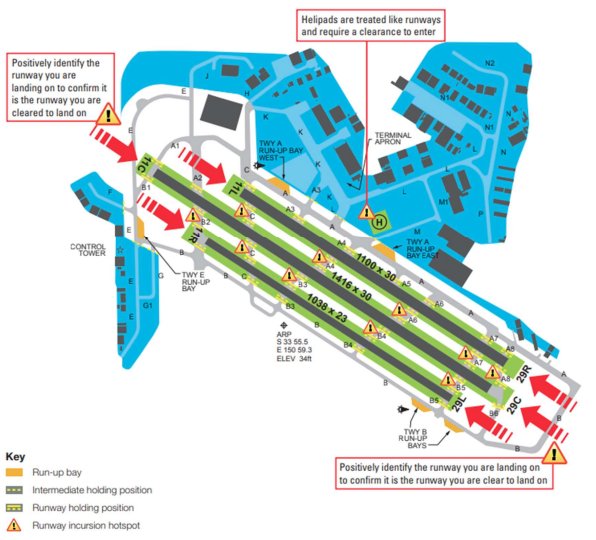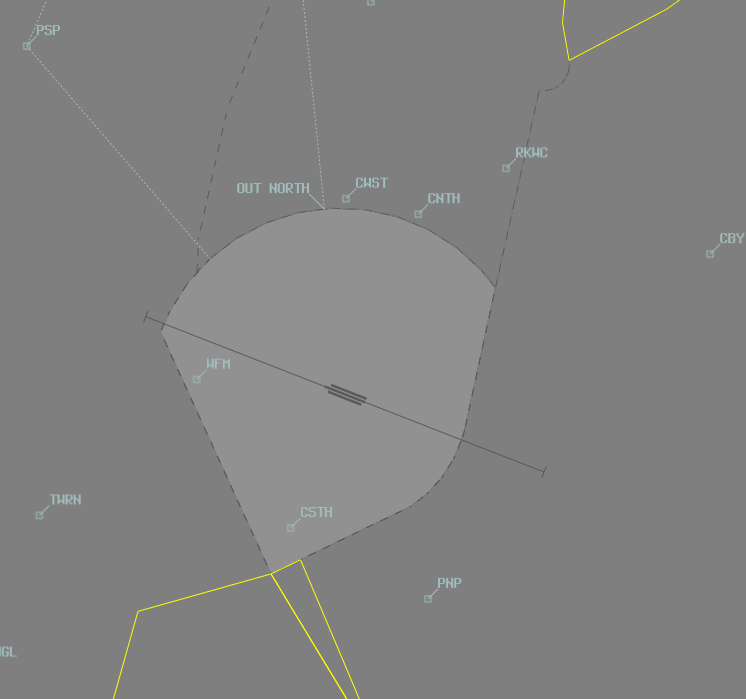Bankstown (YSBK)
Positions
| Name | Callsign | Frequency | Login Identifier |
|---|---|---|---|
| Bankstown ADC | Bankstown Tower | 132.800 | BK_TWR |
| Bankstown SMC | Bankstown Ground | 119.900 | BK_GND |
| Bankstown ATIS | 120.900 | YSBK_ATIS |

Airspace
BK ADC is responsible for the Class D airspace in the BK CTR SFC to A015.

Refer to Class D Tower Separation Standards for more information.
Fixed-Wing Operations
VFR Inbound Procedures
VFR aircraft will report inbound at PSP or TWRN. They should be instructed to join the circuit as below:
| VFR Approach Point | RWYs 29 | RWYs 11 |
|---|---|---|
| PSP | "Join right downwind runway 29R, maintain A015", then when abeam RWYs 11 threshold or clear of departing traffic, "Cleared visual approach" | "Join final runway 11L, report 3nm" |
| TWRN | "Join crosswind runway 29R, maintain A015", then when abeam RWYs 11 threshold or clear of departing traffic, "Cleared visual approach" | "Join final runway 11L, report at Warwick Farm" |
Note
Aircraft joining final in the RWY 11 direction are not assigned a level and are expected to commence a visual approach in accordance with the tracking instructions issued by ADC. Aircraft are required to enter the control zone at A010. There is no need to clear these aircraft for a visual approach.
VFR Outbound Procedures
VFR aircraft should report ready to BK ADC with their departure intentions. A takeoff clearance constitutes a clearance to depart the zone by extending the pilot's requested leg of the circuit. Aircraft departing the zone into class G airspace will transfer to area frequency upon leaving the zone, no explicit frequency transfer is given to these aircraft.
Aircraft departing a leg of the circuit will climb to and maintain the following levels until clear of the zone:
RWY 29 direction: A010
RWY 11 direction: A015
Circuits
The circuit direction changes depending on time of day and runway being used.
| Runway | Day | Night |
|---|---|---|
| 11L | Left | - |
| 11C | Left | Right |
| 11R | Right | - |
| 29L | Left | - |
| 29C | Right | Left |
| 29R | Right | - |
Circuits to be flown at A010
Helicopter Operations
General
These procedures apply during hours of daylight only. During hours of darkness, all helicopters must revert to fixed-wing operations.
The Main Pad (abeam taxiway Mike) is treated like a runway and requires a takeoff/landing clearance. Helicopters are permitted to become airborne from a limited number of other locations on the aerodrome, such as taxiway November Two, and should be instructed to "report airborne" or "report on the ground".
Reporting Points
Three helicopter reporting points help keep helicopters segregated from other traffic.
CWST: Michels Patisserie located 1.2nm west of CNTH on the water pipeline
CNTH: Northern end of Regents Park Railway Station, roughly 300 metres north of the water pipeline
CSTH: Intersection of two creeks enclosing a sewage treatment works 2.1nm south of the aerodrome reference point
Inbound Procedures
Helicopters should track inbound at A007 via one of the normal inbound points (PSP or TWRN) or via Olympic Park and report to BK ADC at that point. In response, BK ADC should instruct the aircraft to track as below:
| Inbound Point | RWY 11 Config | RWY 29 Config |
|---|---|---|
| PSP | "Report CWST", then "Join base main pad" |
"Report CNTH", then "Join base main pad" |
| TWRN | "Report CSTH, A005", then "Overfly midfield at A005, join downwind main pad" |
"Report CSTH, A005", then "Overfly midfield at A005, join downwind main pad" |
| Olympic Park | "Report CWST", then "Join base main pad" |
"Report CNTH", then "Join base main pad" |
Note
Helicopters tracking via CSTH will pass over the runway complex midfield at A005 to join downwind. Be mindful of aircraft in the fixed-wing circuit and pass traffic information to both aircraft prior to the fixed-wing aircraft turning final.
Example:
"LOI, traffic is a helicopter overflying the aerodrome to the north at A005, runway left, cleared touch and go"
"YZD, traffic is a Cherokee turning final for runway left, overfly midfield at A005, join downwind main pad"
Outbound Procedures
Helicopters should track outbound via one of the helicopter reporting points at A007. Departures to the north must track via CWST when RWY 29s are in use and CNTH when RWY 11s are in use.
Helicopters shall report ready to BK ADC with their departure intentions. In response, BK ADC will clear the aircraft for takeoff and instruct them to track via the appropriate exit gate.
Example
YZD: "Bankstown Tower, helicopter YZD, main pad, for Choppers North departure, ready"
BK ADC: "YZD, Bankstown Tower, depart Choppers North, main pad, cleared for takeoff"
Note
Helicopters tracking via CSTH will pass over the runway complex midfield at A005 to join downwind. Be mindful of aircraft in the fixed-wing circuit and pass traffic information to both aircraft prior to the helicopter becoming airborne.
Example:
"XEL, traffic is a helicopter overflying the aerodrome to the south at A005, runway left, cleared touch and go"
"YZD, traffic is a Cherokee turning final for runway left, depart Choppers South, main pad, cleared for takeoff"
Circuits
Circuits are conducted within the lateral confines of the fixed-wing circuit at A007, in the same direction as the current runway config. The termination point of the circuit is the Main Pad.
Example
BK ADC: "SUA, main pad, cleared stop and go"
ATIS
Runway Nomination
The ATIS must indicate the current runway config and nominate what each parallel runway is being used for. The northern runway (11L/29R) is primarily used for VFR arrivals and departures, the southern runway (11R/29L) for circuit training, and the centre runway for IFR arrivals/departures and VFR overflow.
This should be reflected on the ATIS as below:
RWY 11L FOR ARRIVALS AND DEPARTURES; RWY 11R FOR CIRCUIT TRAINING; RWY 11C IN USE
Operational Info
When the crosswind component exceeds 15 knots, the OPR INFO field must include:
CROSSWIND ALERT – DO NOT PASS THROUGH FINAL FOR YOUR ASSIGNED RUNWAY
Coordination
Departures
When the aircraft is ready for departure, Tower will coordinate with the relevant Class C sector above them for permission to release the aircraft into their CTA.
Example
BK ADC -> SY TCU: "Next, UJN, runway 29C"
SY TCU -> BK ADC: "UJN, unrestricted"
BK ADC -> SY TCU: "UJN"
The Standard Assignable level from BK ADC to SY TCU is A030, any other level must be prior coordinated.
Aircraft shall be instructed to contact SY TCU passing A015.
Arrivals/Overfliers
SY TCU will heads-up coordinate arrivals/overfliers from Class C to BK ADC.
IFR aircraft will be cleared for the coordinated approach (Instrument or Visual) prior to handoff to BK ADC, unless BK ADC nominates a restriction.
VFR aircraft require a level readback.
Example
SY TCU -> BK ADC: "via GRB, UJN"
BK ADC -> SY TCU: "UJN, A010"
Tip
Remember that IFR aircraft are only separated from other IFR or SVFR aircraft in class D. You should generally be able to issue a clearance for an approach and use other separation methods (visual separation, holding a departure on the ground) if separation is required with these aircraft.